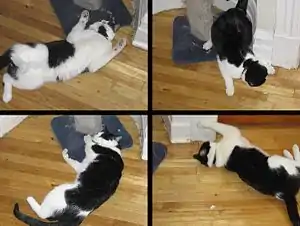Cat pheromone
Cat pheromones are pheromones that are used by cats and other felids for cat communication.
Feline facial pheromone
Feline facial pheromone is a pheromone used by cats to mark places, objects, and persons as familiar by rubbing their face on surfaces. Several pheromones are currently known to exist as "feline facial pheromones" and are produced from glands located around the mouth, chin, forehead and cheeks.
These are only some of the many pheromones that cats produce. Others are from lower back, tail and paws.
Cat attractants

Cat attractants are odorants that have an effect on cat behavior. A cat presented with a cat attractant may roll in it, paw at it, or chew on the source of the smell. The effect is usually relatively short, lasting for only a few minutes after which the cats have a refractory period during which the response cannot be elicited. After 30 minutes to two hours, susceptible cats gain interest again.[1]
Various volatile chemicals, terpenes extracted from essential oils, are known to cause these behavioral effects in cats. They include nepetalactone, found in catnip (Nepeta cataria) and Tartarian honeysuckle (Lonicera tatarica), actinidine from valerian (Valeriana officinalis), and actinidiolide from silver vine (Actinidia polygama). The responsiveness varies between these chemicals as well as between cats.
Cat urine odorants
| Cat urine-like odorants | |||||||||
|---|---|---|---|---|---|---|---|---|---|
| |||||||||
Cat urine, especially that of male cats, contains the putative cat pheromone 3-mercapto-3-methylbutan-1-ol (MMB), a compound that gives cat urine its typical odor. The MMB precursor felinine is synthesized in the urine from 3-methylbutanol-cysteinylglycine (3-MBCG) by the excreted peptidase cauxin. Felinine then slowly degrades into the volatile MMB.[2]
 | → |
| Felinine | MMB |
Rats and mice are highly averse to the odor of a cat's urine, but after infection with the parasite Toxoplasma gondii, they are attracted by it, highly increasing the likelihood of being preyed upon and of infecting the cat.[3]
References
- "How does catnip work its magic on cats?". Scientific American. May 29, 2007. Retrieved 25 July 2014.
- M. Miyazaki; T. Yamashita; Y. Suzuki; Y. Saito; S. Soeta; H. Taira & A. Suzuki (October 2006). "A major urinary protein of the domestic cat regulates the production of felinine, a putative pheromone precursor". Chem. Biol. 13 (10): 1071–9. doi:10.1016/j.chembiol.2006.08.013. PMID 17052611.
- M Berdoy; J P Webster & D W Macdonald (2000). "Fatal attraction in rats infected with Toxoplasma gondii". Proc Biol Sci. 267 (1452): 1591–4. doi:10.1098/rspb.2000.1182. PMC 1690701. PMID 11007336.
External links
- Dr. Jennifer Coates, DVM (22 April 2013). "Synthetic Feline Facial Pheromones: Making Recommendations in the Absence of Definitive Data, Part 1". petMD. Archived from the original on 20 June 2018. Retrieved 16 March 2014.

